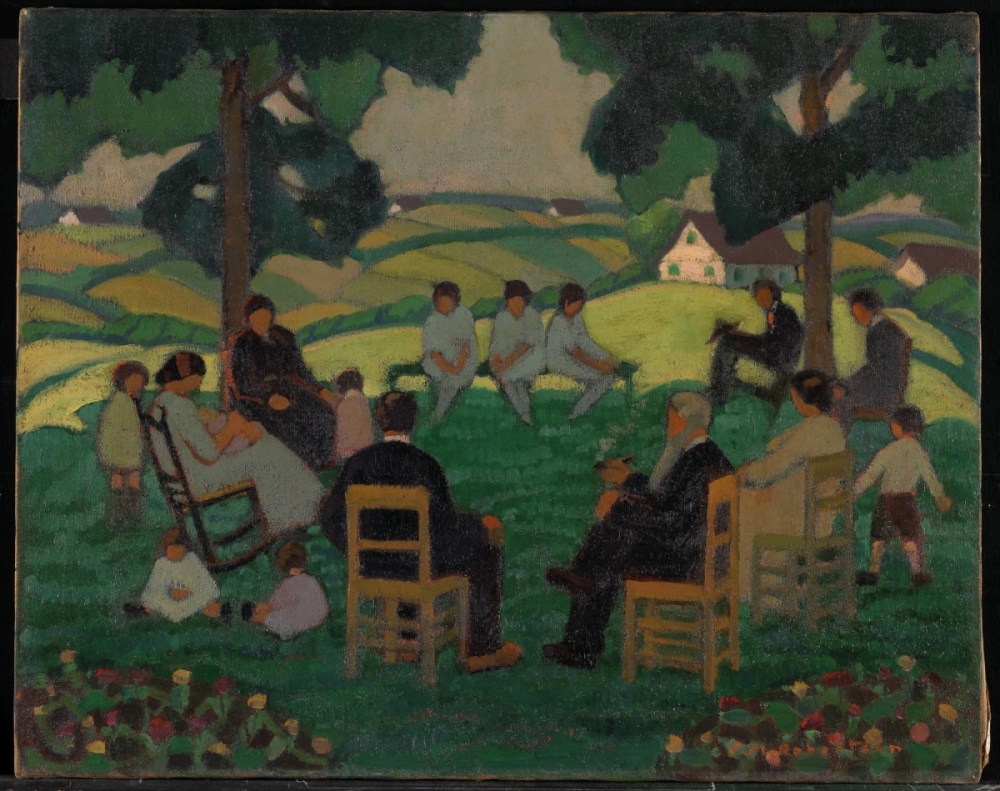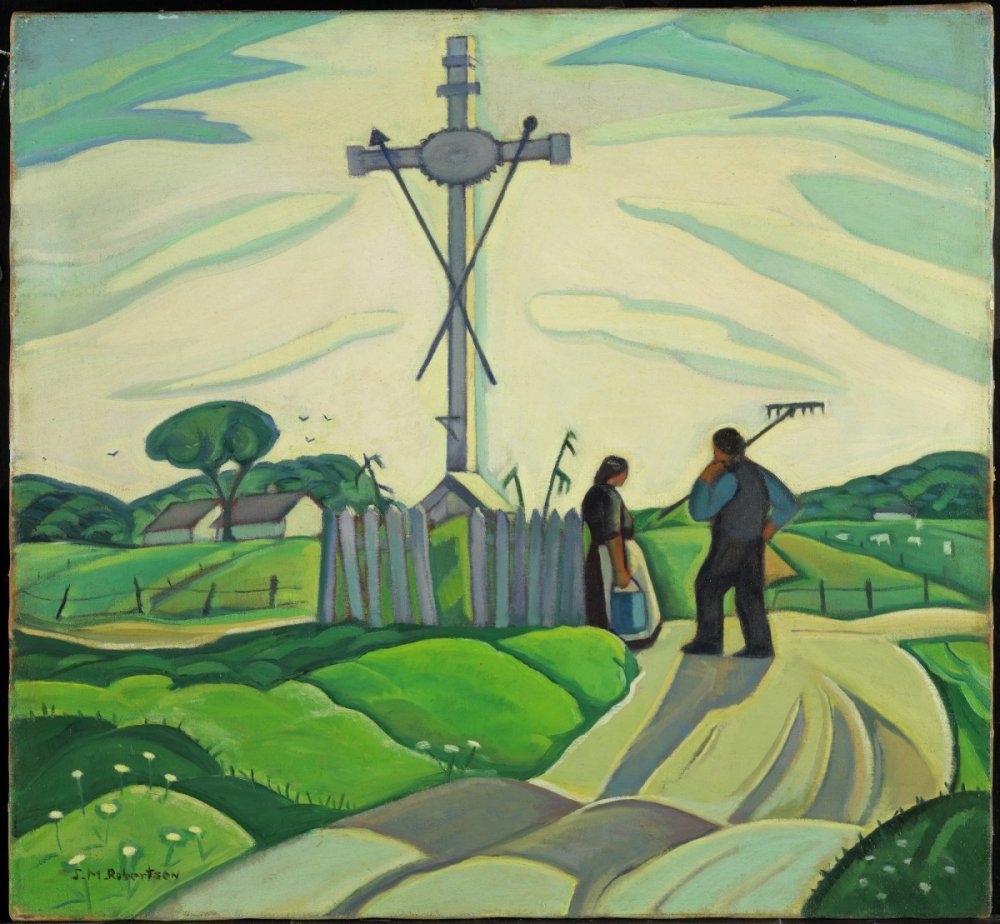Sarah Robertson (painter) on:
[Wikipedia]
[Google]
[Amazon]
Sarah Margaret Armour Robertson (June 16, 1891 – December 6, 1948) was a
 During her last few years at the Art Association, Robertson joined former and current students, and fellow artists, along with her teacher Randolph Hewton, in the
During her last few years at the Art Association, Robertson joined former and current students, and fellow artists, along with her teacher Randolph Hewton, in the
 Robertson's later work was freer in composition and bolder in colors. It reflected her love of nature, and her unique style. She died on 6 December 1948 in Montreal.
Robertson's later work was freer in composition and bolder in colors. It reflected her love of nature, and her unique style. She died on 6 December 1948 in Montreal.
Canadian
Canadians () are people identified with the country of Canada. This connection may be residential, legal, historical or cultural. For most Canadians, many (or all) of these connections exist and are collectively the source of their being ''C ...
painter of landscapes
A landscape is the visible features of an area of land, its landforms, and how they integrate with natural or human-made features, often considered in terms of their aesthetic appeal.''New Oxford American Dictionary''. A landscape includes the ...
, still life
A still life (: still lifes) is a work of art depicting mostly wikt:inanimate, inanimate subject matter, typically commonplace objects which are either natural (food, flowers, dead animals, plants, rocks, shells, etc.) or artificiality, human-m ...
s, portrait
A portrait is a painting, photograph, sculpture, or other artistic representation of a person, in which the face is always predominant. In arts, a portrait may be represented as half body and even full body. If the subject in full body better r ...
s, and murals
A mural is any piece of graphic artwork that is painted or applied directly to a wall, ceiling or other permanent substrate. Mural techniques include fresco, mosaic, graffiti and marouflage.
Word mural in art
The word ''mural'' is a Spanish ...
for private homes.
Early life
Robertson was born in Montreal on June 16, 1891, the daughter of John Armour Robertson and Jessie Anne Christie, and the oldest of four siblings. Her parents were originally from Scotland. She was educated in Montreal. During her childhood, the family lived comfortably, but later faced financial struggles. She began art studies at the age of nineteen with a Wood Scholarship to the Art Association of Montreal underWilliam Brymner
William Brymner, (December 14, 1855 – June 18, 1925) was a Canadian figure and landscape painter and educator. In addition to playing a key role in the development of Impressionism in Canada, Brymner taught numerous artists who became leadi ...
and Maurice Cullen. World War I
World War I or the First World War (28 July 1914 – 11 November 1918), also known as the Great War, was a World war, global conflict between two coalitions: the Allies of World War I, Allies (or Entente) and the Central Powers. Fighting to ...
interrupted her studies, after which she continued them from 1921 to 1924 under Randolph Hewton
Randolph Stanley Hewton (June 12, 1888 – March 17, 1960) was a Canadian artist, known for his figurative work and as a colorist.
Career
He was born in Maple Grove, Quebec, and studied with William Brymner at the Art Association of Mont ...
, a founding member of the Canadian Group of Painters
The Canadian Group of Painters (CGP) was a collective of 28 painters from across Canada who came together as a group in 1933. Its Archives is in Queen's University, Kingston.
Formation
The Canadian Group of Painters succeeded the disbanded Grou ...
, and Wood Scholarship winner.
Artistic career
 During her last few years at the Art Association, Robertson joined former and current students, and fellow artists, along with her teacher Randolph Hewton, in the
During her last few years at the Art Association, Robertson joined former and current students, and fellow artists, along with her teacher Randolph Hewton, in the Beaver Hall Group
The Beaver Hall Group refers to a Montreal-based group of Canadians, Canadian painters who met in the late 1910s while studying art at a school run by the Art Association of Montreal.
The Group is notable for its equal inclusion of men and women ar ...
. A. Y. Jackson was the president of the group named after the Montreal street, Beaver Hall Hill. Robertson became close friends with Prudence Heward. Both painters were dedicated to their art and often painted together. Robertson's work was shown in a solo exhibition at the National Gallery of Canada in 1951. Robertson also exhibited in the United States, in group exhibitions at the Yale University Art Gallery
The Yale University Art Gallery (YUAG) is an art museum in New Haven, Connecticut. It houses a major encyclopedic collection of art in several interconnected buildings on the campus of Yale University. Although it embraces all cultures and period ...
in 1944, the Museu Nacional de Belas Artes
The Museu Nacional de Belas Artes (MNBA; Portuguese for National Museum of Fine Arts) is a national art museum located in the city of Rio de Janeiro, Brazil. The museum, officially established in 1937 by the initiative of education minister , wa ...
in Rio de Janeiro, and the Riverside Museum
The Riverside Museum (replacing the preceding Glasgow Museum of Transport) is a museum in the Partick area of Glasgow, Scotland, housed in a building designed by Zaha Hadid, Zaha Hadid Architects, with its River Clyde frontage at the new Point ...
in New York.
Later life
 Robertson's later work was freer in composition and bolder in colors. It reflected her love of nature, and her unique style. She died on 6 December 1948 in Montreal.
Robertson's later work was freer in composition and bolder in colors. It reflected her love of nature, and her unique style. She died on 6 December 1948 in Montreal.
Associations with other artists and groups
The Beaver Hall Group was aMontreal
Montreal is the List of towns in Quebec, largest city in the Provinces and territories of Canada, province of Quebec, the List of the largest municipalities in Canada by population, second-largest in Canada, and the List of North American cit ...
-based group of Canadian
Canadians () are people identified with the country of Canada. This connection may be residential, legal, historical or cultural. For most Canadians, many (or all) of these connections exist and are collectively the source of their being ''C ...
painters who met in late 1910 while studying art at a school run by the Art Association of Montreal. Nora Collyer, Emily Coonan, Prudence Heward, Mabel Lockerby, Mabel May, Kathleen Morris, Lilias Torrance Newton, Sarah Robertson, Anne Savage and Ethel Seath were part of this group, sometimes known the Beaver Hall Hill Group or Beaver Hall Women. This association of nineteen Montreal artists, eight of whom were women, had been committed to developing distinctive artistic visions while acknowledging the influence of the Group of Seven
The Group of Seven (G7) is an Intergovernmentalism, intergovernmental political and economic forum consisting of Canada, France, Germany, Italy, Japan, the United Kingdom and the United States; additionally, the European Union (EU) is a "non- ...
, and French modernism. The Beaver Hall artists held their annual exhibition at their studios on Beaver Hall Hill. By the end of 1921, the Beaver Hall group ran into serious financial difficulties which necessitated relinquishing their studios. The men went their own way, but most of the women remained in close touch with each other.
In the summers, Robertson would also visit Prudence Heward at her family's summer home near Brockville
Brockville is a city in Eastern Ontario, Canada, in the Thousand Islands region. Although it is the seat of the United Counties of Leeds and Grenville, it is politically Independent city, independent of the county. It is included with Leeds and ...
on the St. Lawrence River
The St. Lawrence River (, ) is a large international river in the middle latitudes of North America connecting the Great Lakes to the North Atlantic Ocean. Its waters flow in a northeasterly direction from Lake Ontario to the Gulf of St. Lawren ...
. At the same time, Robertson also maintained a long correspondence with A.Y. Jackson, who offered vital critical judgment. Jackson was a close friend of both Robertson and Heward. Some of Robertson’s paintings were inspired by her visits to the Hewards' summer home.
Robertson was a founding member of the Canadian Group of Painters
The Canadian Group of Painters (CGP) was a collective of 28 painters from across Canada who came together as a group in 1933. Its Archives is in Queen's University, Kingston.
Formation
The Canadian Group of Painters succeeded the disbanded Grou ...
, exhibiting with them for many years. The group was made up of 28 different English-speaking painters from across Canada. This group was instrumental in establishing a new direction for Canadian art, expressing the diversity of the Canadian experience of landscapes and buildings based on the vision of the Group of Seven.
Exhibitions and collections
Robertson's paintings appeared in exhibitions of Canadian art atWembley
Wembley () is a large suburbIn British English, "suburb" often refers to the secondary urban centres of a city. Wembley is not a suburb in the American sense, i.e. a single-family residential area outside of the city itself. in the London Borou ...
, England, in 1924 and 1925 and she was invited to participate in shows by the Group of Seven
The Group of Seven (G7) is an Intergovernmentalism, intergovernmental political and economic forum consisting of Canada, France, Germany, Italy, Japan, the United Kingdom and the United States; additionally, the European Union (EU) is a "non- ...
in 1928, 1930 and 1931.
Robertson's works are included in the collections of the National Gallery of Canada
The National Gallery of Canada (), located in the capital city of Ottawa, Ontario, is Canada's National museums of Canada, national art museum. The museum's building takes up , with of space used for exhibiting art. It is one of the List of large ...
, the Montreal Museum of Fine Arts
The Montreal Museum of Fine Arts (MMFA) is an art museum in Montreal, Quebec, Canada. It is the largest art museum in Canada by gallery space. The museum is located on the historic Golden Square Mile stretch of Sherbrooke Street west.
The MMFA ...
, the University of Alberta
The University of Alberta (also known as U of A or UAlberta, ) is a public research university located in Edmonton, Alberta, Canada. It was founded in 1908 by Alexander Cameron Rutherford, the first premier of Alberta, and Henry Marshall Tory, t ...
, and the Art Gallery of Ontario
The Art Gallery of Ontario (AGO; ) is an art museum in Toronto, Ontario, Canada. Located on Dundas Street, Dundas Street West in the Grange Park (neighbourhood), Grange Park neighbourhood of downtown Toronto, the museum complex takes up of phys ...
.
Although she mainly painted landscapes in oil
An oil is any nonpolar chemical substance that is composed primarily of hydrocarbons and is hydrophobic (does not mix with water) and lipophilic (mixes with other oils). Oils are usually flammable and surface active. Most oils are unsaturate ...
, she also painted still life
A still life (: still lifes) is a work of art depicting mostly wikt:inanimate, inanimate subject matter, typically commonplace objects which are either natural (food, flowers, dead animals, plants, rocks, shells, etc.) or artificiality, human-m ...
s and portraits, as well as murals for private homes.
References
Bibliography
* Millar, Joyce. "The Beaver Hall Group: Painting in Montreal, 1920-1940." Woman's Art Journal 13.1 (1992): 3. Web. * ''"Independent spirit: early Canadian women artists''." Choice Reviews Online 46.09 (2009): n. page. Web. {{DEFAULTSORT:Robertson, Sarah 1891 births 1948 deaths Painters from Montreal 20th-century Canadian painters 20th-century Canadian women painters